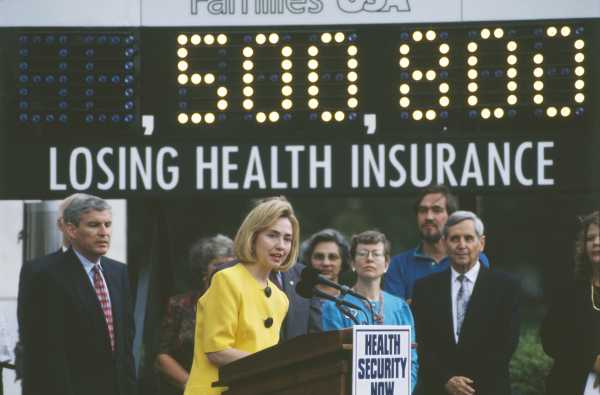
As we head into the next Democratic presidential debate, one of the the sharpest lines of conflict among leading candidates involves health care, and the particular question: Will there be a place for private health insurance in your vision of universal coverage?
In the first Democratic debates last month, a few candidates — Bernie Sanders, Elizabeth Warren, Bill de Blasio, and Kamala Harris (with a caveat) — raised their hands and answered yes, their proposals would ultimately eliminate private insurance. Progressive health policy analysts reacted with alarm. Warren “didn’t have to fall into that trap,” Paul Starr warned. “She may have just filmed the most effective attack ad against herself,” Jonathan Chait said.
The consensus among these pundits is that proposals that leave private insurance largely untouched will be politically safer than a pure single-payer model, both as an election issue and for the future.
Their concerns are well founded, but they depend too much on an assumption: that the design of the policy itself will determine its political fate. Whether health reform takes radical or incremental form, whether it’s called Medicare-for-all, Medicare-for-anyone, or just an expansion of the Affordable Care Act, we will likely see a forceful backlash anyway. We’ve seen this play out again and again over 30 years.
That’s because health care isn’t like other issues. It’s inextricably linked to fear and anxiety, economic survival, illness, and death in our minds. Change, any kind of change, provokes an anxious response, even among those who dislike their insurance or the job that they need to keep their coverage. And that anxiety generally increases with age, which means it also corresponds to the propensity to vote.
Policy design choices aren’t totally irrelevant in whether there’s a public backlash. They have do a lot to do with which interest groups generate opposition and whether key reform constituencies are mobilized.
But it is easy to overstate how important policy design is when thinking through the politics of reform. And by focusing on the details of health policy in their conversations about health reform, the Democratic candidates are missing the chance to focus attention on something far more critical: the difficult political project of building a strong public base deeply invested in reform, one that can withstand the interests that are prepared to provoke and exploit public anxiety.
Health care and a history of backlash
The history of health reform since the 1980s has been one of long periods of inaction punctuated by fierce backlash.
Start the clock when Congress passed the Catastrophic Care Act of 1988 — and then repealed it the very next year in the face of a “New Coke”-style backlash.
The issue came back on the political radar in the early 1990s, signaled by the 1991 special election win by Pennsylvania Sen. Harris Wofford, who ran on the slogan, “If criminals have a right to a lawyer, I think working Americans should have a right to a doctor.” President Clinton in 1993 then brought forth a broad but complex proposal to reform health care. But that plan, lacking a constituency in the public or Congress, died after just a few months, amid a massive public backlash fueled by the health insurance industry and small-business lobbyists.
Over the 15 fallow years that followed, piecemeal reforms didn’t alter the system for working-age adults. The bipartisan Children’s Health Insurance Program and the Medicare prescription drug program modestly expanded health coverage for children and seniors. Al Gore and John Kerry, as Democratic nominees in 2000 and 2004, put forward the most cautiously minimalist plans. It didn’t matter — George W. Bush assailed them with the same apocalyptic language his party hurls at single-payer proposals: Kerry’s proposals would put “Washington bureaucrats in charge” of your health decisions and “lead to rationing.”
Heading into the 2008 election, health reform advocates met for months and crafted for all the candidates a core proposal and a plan of action that took the opposite path from Bill Clinton’s at each decision point: It would have a constituency (the public option won over most single-payer advocates), it would make only modest reforms to existing health insurance plans, it wouldn’t make an enemy of the health insurance industry, and above all, it could plausibly support the necessary promise, “If you like your doctor or your health plan, you can keep them.”
That approach got the Affordable Care Act over the finish line in 2010, and almost a decade later, the ACA has won broad acceptance and remains standing — but only barely. The Republican promise to “repeal and replace” it, while empty and fraudulent, nonetheless dominated the politics of health care for most of the remaining decade, through four consequential elections leading to full Republican control by 2017.
It’s easy to look at each of these episodes and spot mistakes and misjudgments. But three decades of policy history suggests another pattern: Every different strategy — sweeping reform in the 1990s, limited nudges to the system in the 2000s, or Obama’s careful dance to make meaningful improvements with minimal disruption — was vulnerable to backlash. Ideas that polled well and were effective in campaigns quickly became controversial and then deeply unpopular as they moved toward reality.
The backlashes had profound political consequences, but also consequences for health policy itself. The first major backlash, during the early Clinton years, put the issue on the back burner for 15 years. The second, under Obama, made it impossible to refine or repair the ACA, and left 2.5 million people out of Medicaid expansion as Republican governors rejected anything associated with the ACA, even federal money. No other issue or legislation is capable of generating such a fierce public reaction.
Health care is different
There’s an aphorism about American political opinion, dating back to research from the early 1960s, that holds that we’re philosophically conservative but operationally liberal — we say we prefer smaller government, but in practice we support programs that benefit us and even some that don’t.
But health reform seems to follow the inverse dynamic: People appear to support big changes in the abstract, but get skittish and reactionary when the realities of change come into focus, especially when there’s a loud, funded campaign to sow worry. When change does happen, people eventually become comfortable with a new system, and the new system itself changes interest-group dynamics — but it takes time.
To be sure, backlash avoidance is an uninspiring mission for a new president, especially in the current moment. But given the consequences of past backlashes, it would be malpractice not to think through a long-term political strategy that could ensure that reform not only passes, but can be sustained by the support of lasting political majorities, just as what happened with Social Security and Medicare.
That strategy has to go well beyond policy design. Neither keeping nor eliminating private insurance is likely to be a strong protection, in itself, against backlash, especially in the vulnerable period before the new system has been fully implemented. Advocates of middle-ground solutions such as a strong public option are as unjustifiably smug about the politics of their complex approaches as single-payer/Medicare-for-all advocates are about their own.
Consider, for example, former Rep. John Delaney’s campaign proposal, which is one of the more admirably detailed, and touted by centrist organizations such as Third Way. Delaney would provide tax credits for individuals to buy health insurance, but wouldn’t touch employer-provided plans.
Except that he would: Delaney pays for his program by eliminating the tax exclusion for employer-provided health benefits. That’s good policy for several reasons, but it would have effects of its own: Without the tax benefit, some employers, particularly smaller businesses, are likely to reduce or drop coverage, while others might shift more of the premium cost onto employees.
Delaney’s alternative would create far more uncertainty than Sanders’s Medicare-for-all approach, and risks the same sense of false promise that followed Obama’s “if you like your plan, you can keep it” rhetoric. (People who had bought affordable plans with limited benefits, marketed to healthy people on the pre-ACA individual market, were unable to keep them.)
Delaney or other middle-ground advocates might respond just as Sanders has: health plans change all the time. People change jobs; employers reduce or improve coverage or change the employee share of the premium; employers add ever more confusing “choices” such as health savings accounts. This is just one more change and ultimately it would lead to a more stable, predictable system. That may be true. But the instability and churn in the system is exactly what makes people so nervous about change, be it incremental or radical.
For those who profit from the existing health care system, the precariousness of people’s experience is a feature. It keeps them tied to employment, wary of further change, mistrustful of alternatives.
Backlash as a tactic of power
What Democrats and progressives should recognize is that building a sustainable system and avoiding backlash is a political problem, not a problem of policy design. Backlash isn’t a natural force, and people really don’t have a strong preexisting preference for one form of insurance delivery or another. Backlash is a tactic of power that can be claimed by organized interests, such as health insurers, when the broader public is less engaged or demobilized.
There are some obvious strategies to avoid backlash, but most aren’t useful in the case of health reform. One, needless to say, is to do nothing — which is not an option, given the kludgy mess of the current system and the promises that every candidate has made.
Another is to operate by stealth: take the existing health care structure of employer-provided insurance, ACA exchanges and subsidies, and Medicare and Medicaid, and improve each by executive action and rule-making. But it’s hard to imagine reaching the goal of universal coverage that way, without congressional action or court fights that will have a higher profile (and if federal courts substantially invalidate the ACA in Texas v. Azar, we’ll have to start from scratch).
Another protection is to find some kind of bipartisan solution, even just a modest start. Bipartisan agreement on programs such as CHIP has proven a reliable means to confer legitimacy on them. But there’s even less reason now to think that there’s a potential cross-partisan deal on health reform than there was in 2009, and there was none then.
Yet another strategy involves classic interest-group politics: try to neutralize some potential opponents. The Affordable Care Act did this by co-opting the health insurance lobby, the interest group most credited with bringing down the Clinton plan. But that doesn’t work in the current political context — the Republican Party is now totally committed to preventing the extension of health care to all Americans; it’s become part of the party’s political identity. That’s not an interest group that can be bought off.
There’s exactly one option that’s never been tried: Health reform should be treated as a political problem involving power, requiring mobilization and broad public education. In the Obama era, the organization Health Care for America Now (HCAN), built by veterans of the old-line grassroots organization US Action and financed by a few foundations, brought campaign-style advocacy techniques to the fight for the ACA, beginning well before the 2008 election. It succeeded at the legislative task, but it didn’t have enough resources to keep going through the period of backlash or at the state level. There’s never really been an effort that truly engaged the people affected by health policy in the process of designing it.
Such a mobilization needs two dimensions: One, an intense, mobilized core of supporters, on the scale of an election campaign or the anti-Trump “Resistance” groups such as Indivisible. Like HCAN (and unlike the group that became Organizing for America), it should be independent of the White House but well organized and able to pressure wavering legislators and reward supporters. It should also tap into innovations in organizing, such as “deep canvassing,” as well as on- and offline tools developed by advocates, campaigns, and public-interest technology platforms such as NationBuilder.
Two, there needs to be deep and sustained public education that creates a much broader base of knowledgeable citizens who understand the tradeoffs and opportunities in health reform.
Rather than top-down messaging, such a project could include, as one component, an experiment in radical democracy: Dozens of open, town hall-style exercises in public deliberation that would engage tens of thousands of citizens in the process of working through the basic choices in health policy and reaching their own conclusions.
A project called CaliforniaSpeaks tested this idea in 2007, in a large-scale structured deliberative exercise involving 3,500 people in 2007. While it didn’t lead to statewide health reform, research showed that the participants came out with a deeper engagement in the issue and significantly more trust in government.
Such a grassroots-focused approach would involve breaking with the “hundred days” model of the presidency, in which a new president tries to push through as much as possible as soon as possible, before their “mandate” or “political capital” dissipates. That model doesn’t work well for health reform anyway — in both the Clinton and Obama cases, it took most of a year just to get the legislative process going. And with all the other demands on the next president’s time and political capital in 2021, such as reversing the catastrophic regulatory changes of the Trump administration, it won’t be possible to make health reform a real priority, above all others, at the beginning anyway.
Recognizing that, the next president should use time to build support for health reform by campaigning for it. Open up the process to engage citizens; create a real mandate. That would mean leaving much of the policy open at first (let those deliberative exercises work). Once you’ve laid that groundwork, map out the fight — and then move at the moment of maximum advantage.
There is more than one path to the goal of making good health care available to everyone in the United States. But recent history suggests that none of those policy paths is definitively politically safer than another, and the political risks, especially the dangers of another health reform backlash, are considerable. Our best course might be the one we haven’t tried yet — building an enduring public movement centered on health care reform.
We can and should argue about the policy details as policy, in terms of cost, efficiency, fairness, and universality. But those details are not a substitute for a political and mobilization strategy unlike anything we’ve seen in decades.
Mark Schmitt is director of the program on political reform at New America.
Sourse: vox.com






